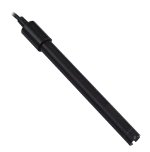DISSOLVED OXYGEN SENSORS COG-1, COG-1t
COG-1 and COG-1t oxygen sensors are designed for measurements of oxygen concentration in natural water, sewage or saline water during laboratory and field measurements. They can also be used for measurements of oxygen in the air. COG-1t is equipped with a built-in temperature sensor.
Characteristic features:
- Wide measuring range which enables usage in highly oxygenated (supersaturated) water.
- High measurement accuracy at an affordable price in comparison with offers of other manufacturers.
- Easy maintenance and short calibration time make working easier.
- This sensor may work for many years, just the user has to remember about simple periodical maintenance operations.
- In case of measurements of oxygen in mg/l the temperature, salinity and atmospheric pressure influence needs to be taken into consideration. The Elmetron meters enable manual or automatic adjustments and corrections.
- The teflon foil membrane provides great chemical resistivity, high selectivity and good oxygen permeability. The membrane is mounted in a cap, which is easy to replace.
- The sensor is equipped with internal temperature compensation system, which makes corrections dependent on the temperature and membrane permeability.
- Negatively charged silver cathode has higher resistance to contamination with sulphides, what makes this sensor very useful in measurements of heavily contaminated liquids like industrial and municipal waste water.
- High accuracy and repeatability of readings can be obtained under condition of a flow of the sample, in close proximity to the membrane (a few cm/s). The lack of flow will result in lowering the reading value due to gradual oxygen consumption, by the sensor, in proximity to the membrane. In vessels without flow a slow, circular movement imitates it and provides stability of reading, using a stirrer can also solve this problem.
- The sensors are characterised by a long term stable signal what makes using it much easier and lowers the costs of maintenance and use.
- For oxygen measurement in the air one point calibration at 20,9 % has to be done, for oxygen measurement in water one and two point calibration is possible at 0 %, and next in the air – at 100 %.
- Gases such as chlorine, sulphur dioxide, hydrogen sulphide, amines, ammonia or carbon dioxide may cause interference in the measurements.
| Measuring range | 0 ÷ 100 % in the air 0 ÷ 600 % in water 0 ÷ 60 mg/l water |
|---|---|
| Accuracy | at calibration temperature: ±1 % * |
| Temperature measurement accuracy | in range 0 ÷ 40 °C ±0.5 °C |
| Acceptable temperature of measured solution | 0 ÷ 40 °C |
| Temperature compensation range |
0 ÷ 40 °C (for mg/l measurement) |
| Signal of the probe in solutions (in 20 °C ) | In 100 % O2 saturation: 20 ÷ 25 mV, in 0 % O2 saturation: max 0.3 mV |
| Signal drift | 0.7 % / 24 h |
| Time of response T99 | below 1 minute |
| Internal compensation | yes (thermistor) |
| Built in temperature probe | yes, Pt-1000B (COG-1t) |
| Cathode material | silver |
| Anode material | zinc |
| Membrane material | teflon foil |
| Body and membrane cap material | PVC |
| Electrolyte | KCl 0.5 mol/l |
| Body diameter | 12.0 ±0.5 mm |
| Body length (to handle) | 120.0mm ±5 mm |
| Cable length | above 1 m |
| Connector | BNC-50 / RCA (chinch COG-1t for temp.) |
| * | By the difference ±5 °C accuracy: ± 3 %, by the difference ±10 °C accuracy: ±5 %. |



